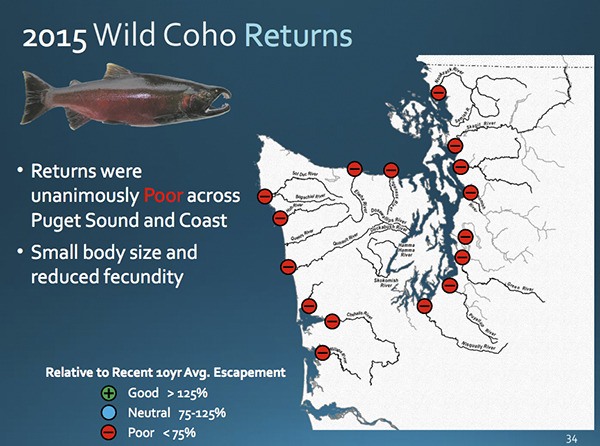Major changes are expected among salmon fisheries.
Based on the 2016 forecasts, “There’s going to have to be some major cutbacks across the board,” Aaron Brooks, Jamestown S’Klallam Tribe fisheries management biologist, said. “The 2016 forecast is extremely low, mostly for chinook and coho. Chum forecasts are actually looking OK and it’s a non-pink year so there is no pink forecast.”
Throughout nearly all of Puget Sound, including the Dungeness River, forecasts for coho salmon are considered at “critical status.” Relative to the most recent 10-year average, less than 75 percent of both wild chinook and wild coho are expected to return to the Dungeness River to spawn.
It’s predicted 344 chinook and a slim 143 wild coho will return to the Dungeness River.
Although “most” of the coho in the Dungeness River come from the state hatchery, even those escapements (number of fish to return to their river of origin) are very low, Brooks said.
The impacts of fewer salmon returning to the Dungeness River and all of Puget Sound range from economic to ecological.
“The ecological impacts could be huge,” Brooks said. “Anything that depends on these salmon will be affected.”
Many organisms, from small fish and insects to birds and mammals, rely on the salmon as a food source, he said, as salmon provide nutrients for the entire river system.
As for impacts to fisheries — those negotiations are underway through the North of Falcon process and coinciding Pacific Fishery Management Council. During the annual process, federal, state and tribal fishery managers collaborate to plan recreational and commercial salmon fisheries for the Northwest.
Among the managers there’s a shared “consensus that things don’t look good and we have to make some major changes,” Brooks said. “Based on this year’s forecasts, if we fish the same fishing schedule that we fished last year there would be no salmon left to return to the (Dungeness) river.”
The process concludes mid-April.
A variety of reasons are thought to be driving the projected poor returns, including drought, low river flows, extreme high flows and unfavorable ocean conditions.
Low flows in the Dungeness River driven by the drought last year were hard on returning chinook and pink salmon, Brooks said.
Both the Jamestown S’Klallam Tribe and Washington Department of Fish and Wildlife had to do a lot of work in the river to help the fish travel upriver to spawn.
Additionally, once the rain did begin to fall the low flows were quickly replaced by extreme high flows.
“There are several pieces of the river where chinook were spawning last summer that are either dry or under 8 feet of gravel now because of the way the river has changed this last winter,” Brooks said.
Shifts in the river are a natural phenomenon, but it’s when it happens multiple times throughout a season, like last winter, it can be “devastating” to the salmon eggs, he said.
Harvest in Alaska and Canada of Puget Sound salmon also can have an impact on the returns. For example, Alaska harvested 100,000 chinook over its quota, Brooks said.
Lastly, “unfavorable ocean conditions” are likely impacting salmon survival.
“The ‘Blob’ (warm ocean water occurring off the west coast of the U.S. and Canada) is believed to be the cause for really poor marine survival last year,” he said. ”There’s been reports lately that this El Niño is really fighting the Blob, so a lot of people think this should have a positive effect on this warm water.”
As a possible reflection of changes in ocean conditions, like food availability, the coho that returned to the area in 2015 were overall smaller than average, Brooks said. Egg size was smaller and the amount of eggs produced was lower than average.
Brooks and his colleagues are looking into grants to buy sonar equipment, which would be used in local rivers and streams like the Dungeness to improve data collections and overall estimations.
For more information on salmon fishing season, visit wdfw.wa.gov/fishing/northfalcon/.
Salmon seasons may close
Poor forecasts for returning coho salmon are prompting state and tribal fishery managers to consider closing all salmon fisheries in Washington’s ocean waters this year as part of a federal season-setting process for the West Coast.
State, tribal and federal fishery managers have developed three options for non-treaty ocean salmon fisheries that reflect the anticipated low coho returns. Two options would permit some salmon fishing this year, but one would close recreational and commercial ocean fisheries for chinook and coho salmon. A public hearing on the three alternatives for ocean salmon fisheries is scheduled for March 28 in Westport.
For details about the options, visit the Pacific Fishery Management Council webpage at www.pcouncil.org.



